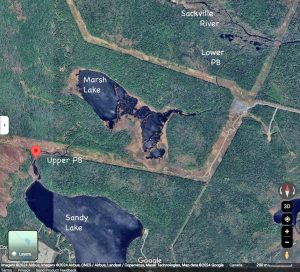Update July 29, 2024: View the DFO’s Draft Atlantic Salmon Strategy; opportunity to comment open June 27, 2024-July 30, 2024. Apologies, I just became aware of it on July 29th, unfort. not the only one! – dp
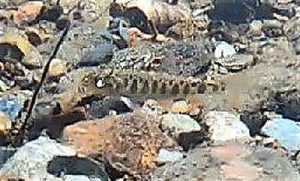
Salmon Parr spotted in upper Peverill’s Brook, June 14, 2024 “Toward the end of their first year, young salmon develop characteristic dark bars along their side with red spots distributed in between them and are referred to as parr. These markings help fish blend into their environment to avoid predators”- Source: Atlantic salmon… a remarkable life cycle (Fisheries and Oceans Canada). Photo extracted from GoPro Video taken by Karen Mckendry.
Click on images for larger versions
Sandy Lake enthusiast and EAC’s Wilderness Outreach Coordinator Karen McKendry was curious about the state of upper Peverills Brook where it begins at the bottom of Sandy Lake, and in particular, whether she could she any evidence of Atlantic Salmon there.
Comments Karen” I was concerned that statements made in the recent Land Suitability Analysis for the Sandy Lake area downplay the fact that there are currently salmon coming into Sandy Lake from the Sackville River – not just historically. The Sandy Lake – Sackville River Regional Park Coalition has multiple instances in recent years where reliable sources have observed salmon in the lake or Peverill’s Brook. ”
Paddling into upper Peverills Brook on June 14th of this year, Karen spotted some small fish in the shallows and put her G0-Pro camera into the water, capturing a short video and a still photo of a small fish with distinct vertical bars.
Karen showed her footage to Walter Regan, who has led efforts to re-establish salmon in the Sackville River Watershed. “Yup, that’s a one-year old” he said. “It developed from eggs laid by an adult which then moved into Sandy Lake where it could reside in the cooler, deeper waters during the hot days of summer.”
Karen also posted her photo on iNaturalist. It was quickly confirmed as Atlantic Salmon.
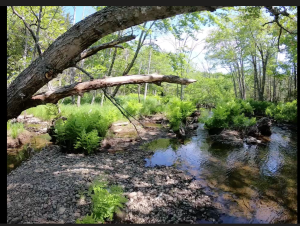
“This is what Peverills Brook looks like at the spot I took the video” – Karen Mckendry. View Site Video
In a sense, this is no surprise as there have been earlier reports of salmon fry, smolt and grilse sightings within the last few years (view Post, 3 May2022).
But it’s good news, and reflects the efforts of the Sackville River Association to re-establish salmon in the Sackville River system.
Mainly due to acid rain, habitat loss due to urbanization, and, in past years, fish blockage due to dams, the Atlantic Salmon population of the Sackville River was believed to have been lost, so a restoration program was begun in the mid-1980s. This was done with the release of hatchery raised fish from a nearby donor river. Although this resulted in early success, recent and continued low marine survival for salmon populations along Nova Scotia’s Atlantic coast have resulted in low numbers of adult salmon returning to the Sackville River. To remedy this, it was decided to continue to supplement resident Atlantic Salmon stock numbers by the introduction of hatchery raised Atlantic Salmon. The Atlantic Salmon that have been stocked in the river are fry and parr (0-1 year old fish) and smolts (1 year fish, ready to go to sea), see below for years and numbers.
All salmon smolts are stocked in the spring, usually around late May, while fry and parr are stocked in the fall, around late October. [From SRA on the Web Archive: Fish Stocking]
Those efforts have included placing digger logs on Peverill’s Brook.

Sackville River Sub-Watersheds as identified in Sackville River Watershed Wetland Inventory (2010). Text for Sandy Lake, Marsh Lake and Peverills Brook (“PB”) inserted.
Click on image for larger version.
Sandy Lake is the largest or second largest sub-watershed of the Sackville River Watershed (the order depends on how the sub-subwatersheds are aggregated). Peverill’s Brook drains Sandy Lake, goes through Marsh Lake and finally enters the Sackville River not far from from its mouth.
Salmon are monitored at a fish ladder was “installed in cooperation with DFO on the main Sackville River in 1990 to allow unimpeded fish migration past the falls at Hefler’s Lumber Mill.on the main Sackville River in 1990 to allow unimpeded fish migration past the falls at Hefler’s Lumber Mill” (view Source.)
Salmon monitored at the fish ladder do not include Salmon that migrate into the Sandy Lake sub-watershed, as Peverill’s Brook enters the Sackville River lower down. So we don’t really know how important the Sandy Lake Watershed is to the overall efforts but it is likely substantial. The observations of salmon in the Sandy lake watershed in the last few years are encouraging, especially given the overall low numbers at the fish ladder since 2012.
On the concern side, however, are the low oxygen levels in deeper waters of Sandy Lake – until last year when the heavy rains evidently flushed Sandy Lake top to bottom:

Fig 3. Near-bottom oxygen levels in deepest area of Sandy Lake 1971 to 2023. Observations on Aug 30, 1971; Sep 2, 1998; Oct 3, 2017; Sep 30, 2019; Aug 22, 2022; Aug 14, 2023; & (Doucet) Aug 16-23 interval in 2021. View Post Mar 21, 2023 for details.These are dramatic changes, and are attributable to the episodic rainfall events in mid-summer of 2023.
The increased late summer deep water oxygen in 2023 may or may not be good news, depending on the other effects of the heavy rainfalls.
Of additional concern, our limnological monitoring revealed a new phenomenon in recent years: a “metlimnetic oxygen minimum” (MOM) in the shallower waters. In both situations – the deep oxygen levels until last year and the MOM in shallower waters in recent years – the oxygen levels were well below those required by salmonids.
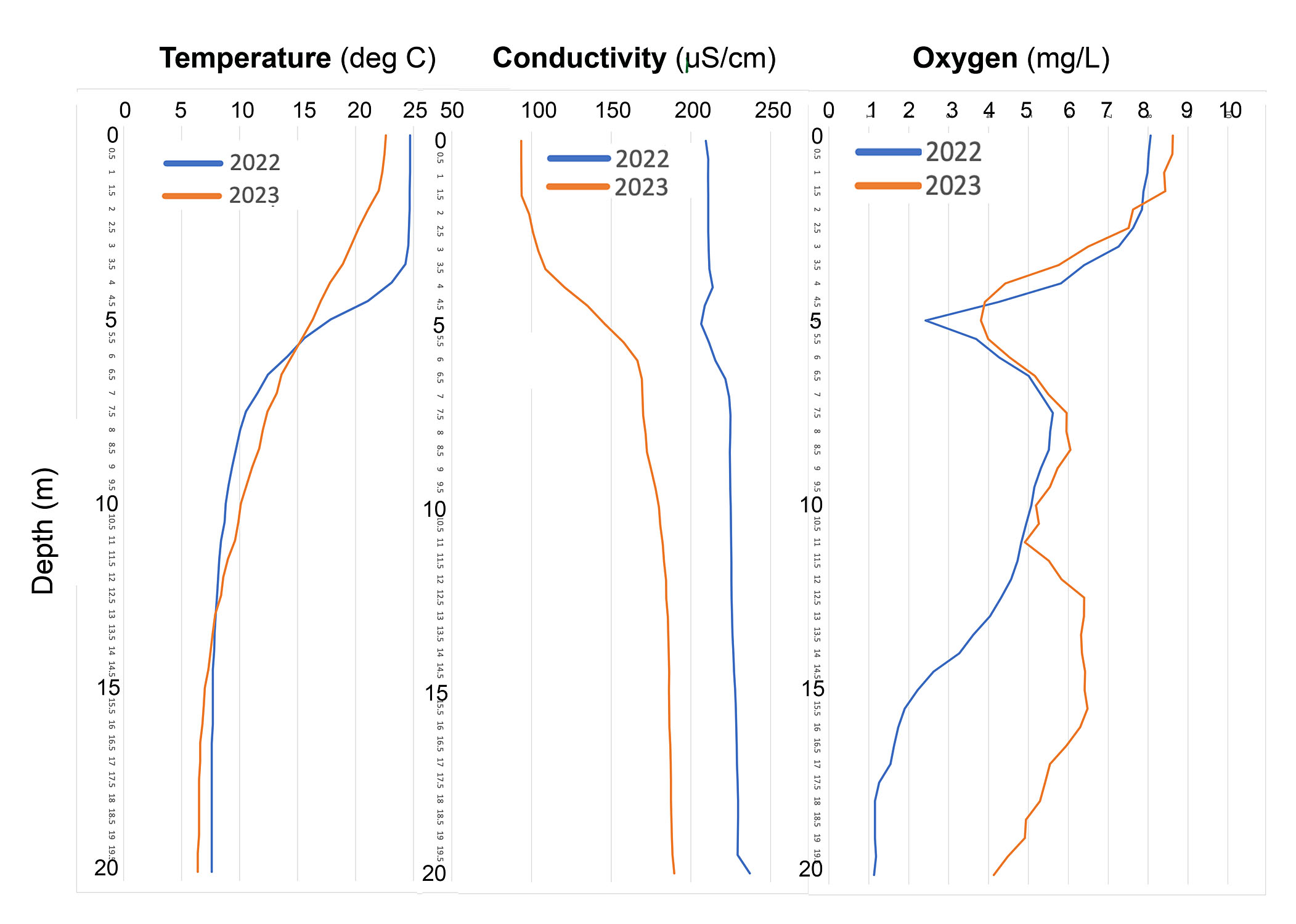
Temperature, conductivity and oxygen profiles on Aug 22, 2022 (blue) and Aug 14, 2023 (orange). See 2023 Limnological Profiles & effects of episodic precipitation (this website) for details. Note the gradual decline in temperature in 2023, versus the existence of a distinct zone of large temperature change (the “thermocline” or the “metalimnion“) between 3 & 7 m in 2022; however there is a much sharper change in conductivity in that depth interval in 2023 compared to 2022, i,e. more pronounced salt stratification. Conductivity values in 2023 were much lower than in 2022 through the entire water column. View Dimictic Lakes on Wikipedia for a brief description of the type of lake stratification we have in Sandy Lake, and the zones (epilimnion, metalimnion, hypolimnion).
The oxygen observations indicate that Sandy Lake is in a highly precarious state and needs management now to reduce input of organics, nutrients and silt, let alone attempt to mitigate the effects of new development already approved (subarea 12) and the large development being considered (re: Future Service Communities).
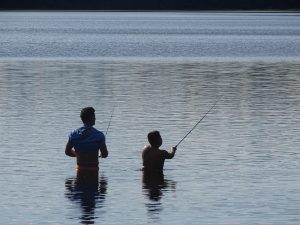
Father & Son fishing for small-mouthed bass off of Sandy Lake Beach Park
By removing this invasive species, they help the native species.
Surely, our iconic but threatened Atlantic Salmon are worth the effort. Not coincidentally, all of the other species including Homo sapiens that currently live by, in or visit Sandy Lake will also reap the rewards.
Thanks to Karen M for giving us hope that we are, at least, at a good starting point in regard to salmon in Sandy Lake.
And Thanks to the Sackville Rivers Association for the many improvement you have made or fostered in the Sackville River system at large that benefit all species.

